A Colonial Masterpiece Brings $218,300
July 29th, 2015
|
Two full pages in the catalog were devoted to the 44" x 43" x 23" walnut desk by cabinetmaker Robert Walker that sold for $218,300 (est. $150,000/250,000). The large batwing brasses were original. See story for details.
These large (22" tall) cast bronze figural andirons by Louis McClellan Potter (1873-1912) got the attention of many at the preview. Stamped “Roman Bronze Works” of New York City, the pair sold to a phone bidder for $10,030 (est. $3000/5000).
You couldn’t miss these 100½" x 48" storks with palm trees. They greeted visitors as they entered the gallery’s front door. These over-the-top ornaments were made by Anthony Redmile of London, circa 1960. Note the ostrich egg finials nestled in the palm trees. Museum services and website content manager Lauren Brunk could not resist having her picture taken with them. No one in house bid on the storks; it was all phones and Internet, and they went to a phone bidder for $31,860 (est. $12,000/18,000).
The top lot from The Pierre consignments was this Art Deco 17½" x 25 7/8" x 18½" woman’s desk or vanity and bench that sold to the phones for $11,210 (est. $1000/1500).
The Meet at White Horse Tavern, a 20 1/8" x 24 1/8" signed and dated (1923) oil on canvas by Charles Morris Young (1869-1964), sold for $49,560 (est. $12,000/18,000).
These George III mahogany dining chairs were the top lot in the Tom Devenish collection. They brought $20,060. See story for more details.
This pair of Haywood family Federal games tables was discussed in John Bivins Jr.’s 1989 book Wilmington Furniture, 1720-1860. Bivins noted, “North Carolina card tables are rare and the survival of a pair is exceptional.” Each table is 29" x 35½" x 18" and opens to 35½". The pair sold for $42,480 (est. $15,000/25,000).
Oil executive and banker George Hathaway Taber Jr. (1859-1940) was a prolific collector of Chinese ceramics. This 15¼" tall Chinese double-handled earthenware vase came from his collection. An Internet bidder claimed it at $15,340 (est. $800/1200).
|
Brunk Auctions, Asheville, North Carolina
Photos courtesy Brunk Auctions
When cabinetmaker Robert Walker (1710-1777) left Scotland in the 1740s, he brought to colonial Virginia a familiarity with the latest early 18th-century British designs. He combined three of those elements—hairy paw feet, knees carved with lion’s heads, and a bust of a Roman statesman—into one secretary/bookcase for Virginia’s Royal Governor Thomas Lee. “[Walker] possessed a sense of style unparalleled among his colonial counterparts,” wrote Sumpter Priddy in an article about Walker and the desk in Antiques and Fine Arts (Spring 2009).
The circa 1750 walnut slant-front desk (minus its bookcase) was at the center of the May 15 and 16 sale at Brunk Auctions. It was the only lot from the estate of Levon Register (1927-2013), a Georgian certified public accountant with Arthur Andersen & Co. Register and his wife, Elmaise Turnage Register, were avid collectors and antiques dealers. Their son Levon Register II attended the sale.
Based on research undertaken by Robert Leath of the Museum of Early Southern Decorative Arts, Winston-Salem, North Carolina, Priddy cited a number of influences on Walker’s artistry. Among them were several publications of British designer Batty Langley (1696-1751). Langley’s 1729 work A Sure Guide to Builders showcased a carved profile over a doorway similar to the one that Robert Walker included on the prospect door of the Lee desk.
“In the pantheon of Virginia furniture, few objects rank as important as this desk,” said auctioneer Andrew Brunk as the desk crossed the block. It opened at $75,000 with five phones active. With bids progressing in $5000 increments, Brunk had three phone bidders in play at $130,000. It was down to the last two at $140,000. One gave a quick response; the other was slow and deliberate. The hesitant bidder faded, and the quick responder, a Virginia private collector, prevailed at $218,300 (includes buyer’s premium). The estimate was $150,000/250,000.
“If anyone finds the upper case, you have my number,” quipped Brunk as the audience applauded the drop of the gavel. The Walker desk was the top lot of the 690-plus-lot, $1.46 million sale.
Americana dominated the next four high-dollar lots. The second-highest lot was a rare small Federal mahogany tall-case clock with works by Simon Willard (1753-1848). A note inside the case listed the original owner as Abel Drury of Massachusetts and the earliest date as December 1, 1803, his wedding day. The dial is arched and painted, and it has a seconds hand and moon phases. The finely crafted clock with three original brass eagle finials, a line-inlaid hood door, waisted case with brass-inlaid quarter columns, and original ogee bracket feet opened at $20,000 and sold to a phone bidder for $59,000 (est. $30,000/50,000).
The Meet at White Horse Tavern, a signed and dated (1923) oil on canvas by Charles Morris Young (1869-1964), also opened at $20,000 with strong absentee and phone participation. The painting’s carved and gilt frame was signed by noted Philadelphia frame maker Philip Yates. The framed painting sold to a phone bidder for $49,560.
A pair of North Carolina Federal games tables followed immediately after the Robert Walker desk. There may have been a bounce effect, but these rare tables needed little help. With perfectly matched tops, the pair had been made in Wilmington, North Carolina, between 1790 and 1810 and descended in the John Haywood family. John Haywood was North Carolina’s first treasurer and the first mayor of the state capital, Raleigh. These tables stood in Haywood Hall, where the Marquis de Lafayette was a guest in 1825. The inlaid tables sold to a phone bidder for $42,480 (est. $15,000/25,000).
When he was chairman of the United States Steel Corporation, Irving S. Olds had purchased at Parke-Bernet Galleries in 1964 the lot that became the fifth-highest-priced object in this Brunk sale. The mid-18th-century walnut and maple high chest of drawers from coastal Massachusetts had one fan-carved drawer just below the center finial and another just above the two skirt drops. The finely made chest opened at $10,000 and sold to a phone bidder for $40,120 (est. $20,000/30,000).
Andrew Brunk and his father, Robert, have developed a reputation over the years for conservatively estimating Asian antiques. The textbook example was in May 2009 when a 12" Chinese famille rose vase with flowers on a pale yellow ground, thought to be a copy and with an estimate of $400/800, sold for a spectacular $1,236,250. The May 2015 underestimates were not quite so dramatic, but audience gasps were audible soon after a pair of Chinese armchairs decorated with porcelain and mother-of-pearl came up for sale. The pair was consigned by Bob Jones University, Greenville, South Carolina. The estimate of $800/1200 was passed from the get go when the chairs opened at $1600. One curious floor bidder hid behind a screen to conceal his bids from others in the room. That charade meant little because the great unseen Internet took the pair for $35,400.
Fourteen lots later up popped another nearly identical pair of Chinese armchairs. These two were also from Bob Jones University with the same estimate. Was the first pair a fluke? Hardly. The chairs opened at $2800, and the “hiding bidder” was in at $17,000 and $20,000. He lost again to an Internet bidder, who claimed the pair for $33,040.
A Chinese bronze Quanyin figure made into a lamp was the lot that broke the run of high-dollar Americana antiques. The standing figure from the late Qing period was marked “Yutang Shi Sou” on the back. Internet bidders were all over the 19¼" bronze figure. It sold for $37,760 (est. $1000/1500).
The sale included three noteworthy collections.
Thomas “Tom” Devenish, a British-born dealer in fine English furniture, was a colorful figure in New York City’s art world for decades. Six years after his death in 2002, his collection of 18th-century British antiques moved from his shop at 929 Madison Avenue to Sotheby’s salesroom. Eighteen lots that had failed to sell in 2008 were consigned to Brunk Auctions by the Devenish family. Comparing the two catalogs, Sotheby’s estimates for the unsold lots were two to three times higher than those at Brunk. Even with the lower estimates, four Devenish lots were passed, and 12 sold below the low estimate. Only two sold within estimate. In a New York Times article before the Sotheby’s sale, Bernard Karr, owner of Hyde Park Antiques, had said that Devenish’s antiques were priced “higher than retail.” That may be the case for his auction estimates as well.
The top Devenish lot was the first to cross the block—a set of 12 George III carved mahogany shield-back dining chairs. The brass-tack leather seats on the two armchairs were cracked; the others seemed in usable condition. The circa 1785 chairs opened at $15,000 and sold moments later to a phone bidder for $20,060. The Brunk estimate was $30,000/50,000; Sotheby’s had estimated the set at $100,000/150,000.
Movie and television actor and director Ron Howard and his wife, Cheryl, consigned 52 lots to the sale with proceeds going to benefit the Mount Vernon Ladies’ Association. At least half of the Howard lots were period Arts and Crafts items. The top lot in the Howard collection was also one of the more unusual and practical pieces in the sale— a family-size Victorian-style figured cherry lazy-Susan dining table. The 20th-century item was a whopping 80¼" across. It sold to an absentee bidder for $2832 (est. $1000/2000).
The collection from an apartment at The Pierre at East 61st Street and Fifth Avenue in New York City set no price records, but the intrigue factor was sky high. According to Robert Ruggiero, Brunk’s trusts and estate specialist, 65 lots from an apartment at The Pierre were consigned. The furnished apartment sat unoccupied for at least the past five years, said Ruggiero. The consignor had lived there prior to the vacancy and is said to have purchased the furnishings from Gianfranco Gobbi. Of the lots identified as coming from The Pierre, the leader was an Art Deco walnut and shagreen veneer and chrome woman’s desk or vanity. The circa 1930 possibly French desk included a burlwood veneered pedestal bench. The set sold to the phones for $11,210 (est. $1000/1500).
 New at Brunk Auctions were complimentary wine, cheese, and craft beer at the Friday night preview and sale. Brunk repeated the largess after lunch Saturday. Drinking and noshing were confined to the gallery’s dining area, but flat screen monitors kept diners in touch with the sale.
New at Brunk Auctions were complimentary wine, cheese, and craft beer at the Friday night preview and sale. Brunk repeated the largess after lunch Saturday. Drinking and noshing were confined to the gallery’s dining area, but flat screen monitors kept diners in touch with the sale.
For more information, contact Brunk Auctions as (828) 254-6846 or visit the website (www.brunkauctions.com).
|
|
|
|
|
|
|
|
|
|
|
|
Originally published in the August 2015 issue of Maine Antique Digest. © 2015 Maine Antique Digest






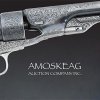












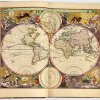


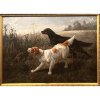

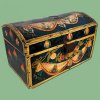
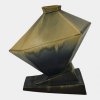


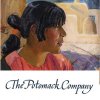













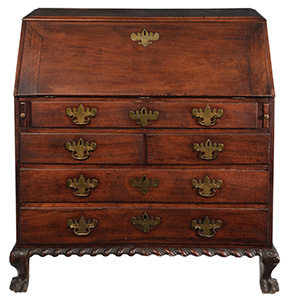
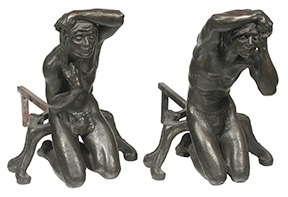
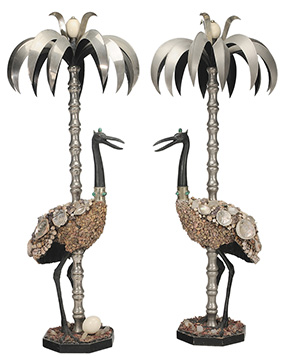
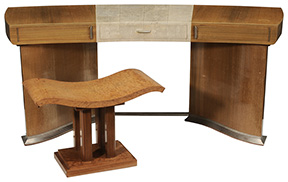
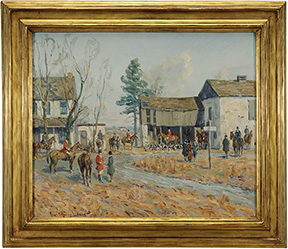
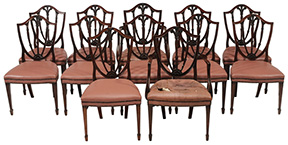
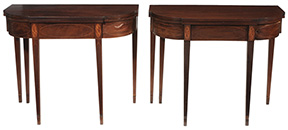
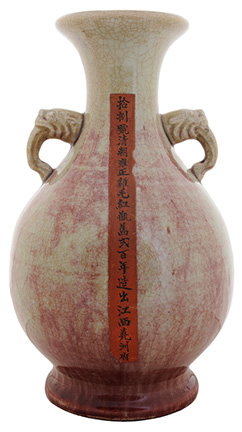
 Six phones were active when this 76½" x 27½" x 23" Black Forest carved umbrella stand came up for sale. From Switzerland in the late 19th century, it sold to a phone bidder for $9440 (est. $4000/6000).
Six phones were active when this 76½" x 27½" x 23" Black Forest carved umbrella stand came up for sale. From Switzerland in the late 19th century, it sold to a phone bidder for $9440 (est. $4000/6000).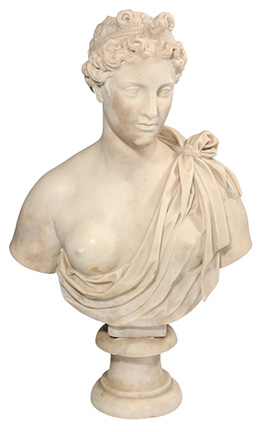 This 34" marble bust of Diana descended in the family of John Lawrence Manning (1816-1854), who was a governor of South Carolina (1852-54) and builder of Milford Plantation near Pinewood, South Carolina. Manning purchased the bust from Count Joseph Binda, a noted art importer and secret agent of the French Foreign Ministry. After an absentee opened at $7000, six phones got busy. It was down to three at $19,000 and then two at $24,000. It sold for $35,400 (est. $6000/9000).
This 34" marble bust of Diana descended in the family of John Lawrence Manning (1816-1854), who was a governor of South Carolina (1852-54) and builder of Milford Plantation near Pinewood, South Carolina. Manning purchased the bust from Count Joseph Binda, a noted art importer and secret agent of the French Foreign Ministry. After an absentee opened at $7000, six phones got busy. It was down to three at $19,000 and then two at $24,000. It sold for $35,400 (est. $6000/9000).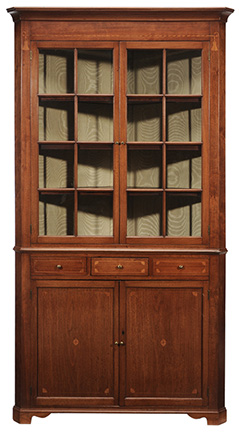 A potential bidder for this 19th-century Washington County, Tennessee, Federal inlaid walnut corner cupboard noticed that the top shelf had been electrified. “They treated it as if it were just a piece of furniture,” she remarked. The on/off toggle switch was just behind the right facing panel door. It was also refinished and restored, as noted in the catalog. The 90" x 48½" x 22" tassel-inlaid cupboard opened at $3000 and sold to an on-site bidder for $10,620 (est. $3000/5000).
A potential bidder for this 19th-century Washington County, Tennessee, Federal inlaid walnut corner cupboard noticed that the top shelf had been electrified. “They treated it as if it were just a piece of furniture,” she remarked. The on/off toggle switch was just behind the right facing panel door. It was also refinished and restored, as noted in the catalog. The 90" x 48½" x 22" tassel-inlaid cupboard opened at $3000 and sold to an on-site bidder for $10,620 (est. $3000/5000).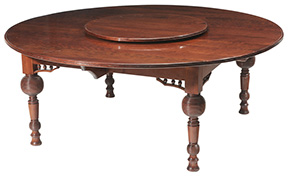 The top lot from the Ron and Cheryl Howard collection was this 20th-century Victorian-style lazy-Susan dining table. The practical table sold for $2832 (est. $1000/2000). Prunkl photo.
The top lot from the Ron and Cheryl Howard collection was this 20th-century Victorian-style lazy-Susan dining table. The practical table sold for $2832 (est. $1000/2000). Prunkl photo.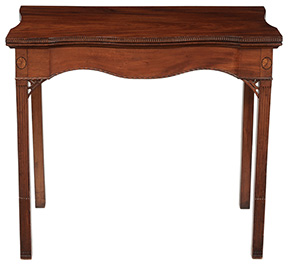 Check out page 280 of Albert Sack’s 1950 book Fine Points of Furniture, Early American for a photo and description of this Rhode Island Federal figured and inlaid games table. Possibly by John Townsend from 1790-1800, the 28½" x 31½" x 15¼" table opened at $6000 and jumped past its high estimate to sell to a phone bidder for $28,320 (est. $10,000/15,000).
Check out page 280 of Albert Sack’s 1950 book Fine Points of Furniture, Early American for a photo and description of this Rhode Island Federal figured and inlaid games table. Possibly by John Townsend from 1790-1800, the 28½" x 31½" x 15¼" table opened at $6000 and jumped past its high estimate to sell to a phone bidder for $28,320 (est. $10,000/15,000).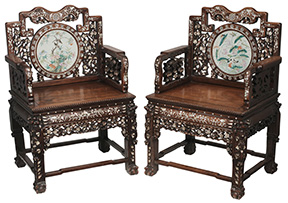 This is the first pair of 39¾" x 27" x 20½" Chinese armchairs decorated with porcelain and mother-of-pearl. The modest estimate ($800/1200) was demolished. The pair sold to an Internet bidder for $35,400. (The second pair of similar chairs sold for $33,040.)
This is the first pair of 39¾" x 27" x 20½" Chinese armchairs decorated with porcelain and mother-of-pearl. The modest estimate ($800/1200) was demolished. The pair sold to an Internet bidder for $35,400. (The second pair of similar chairs sold for $33,040.)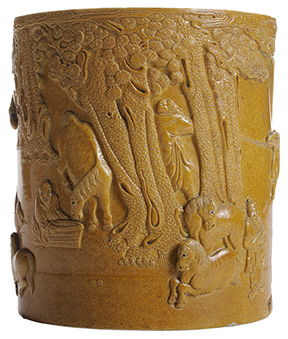 Chinese brush pots were hot and underestimated. This 6" high monochrome pot from the late 19th century went from a modest $800/1200 estimate to $17,700. Another pot (not shown) did even better. It was cinnabar with finely carved figures in an elaborate mountain landscape. From an opening bid of $1000, it soared to $33,040 (est. $400/700).
Chinese brush pots were hot and underestimated. This 6" high monochrome pot from the late 19th century went from a modest $800/1200 estimate to $17,700. Another pot (not shown) did even better. It was cinnabar with finely carved figures in an elaborate mountain landscape. From an opening bid of $1000, it soared to $33,040 (est. $400/700).




